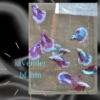Introduction: Betta Simorum
Sim's Betta, scientifically known as Betta simorum, is a captivating species of fish native to the peat swamps of Jambi and Riau in Sumatra. Known for their striking appearance and intriguing behaviors, these fish make a fascinating addition to any aquarium. This guide will provide a detailed overview of Sim's Betta, covering their origin, habitat, size, aquarium requirements, water conditions, diet, breeding practices, and more.

Origin and Habitat
Betta simorum was first described by Heok Hui Tan and Dr. Peter Ngin in 1996. The species is named after Thomas Sim, a notable fish collector who, along with his wife, discovered these fish in the wild using baited cages. Sim's Betta is closely related to Betta bellica, with notable differences such as the sloping profile of the head and elongated pelvic fins.
These fish are found among leaf litter in the shallow peat swamps of Sumatra, where the water has a low pH ranging from 3.0 to 4.0. This unique habitat contributes to their specific care requirements in captivity.

Physical Characteristics and Size
Sim's Betta can grow up to 10 cm (4 inches) in length. The body is predominantly light brown, but the scales exhibit a resplendent iridescent green hue, making both sexes equally stunning. Mature males have a tail fin shaped like the ace of spades, which can propel them with impressive speed and agility. Due to this, it is crucial to keep a well-fitting lid on their tank to prevent any escape attempts.
Aquarium Setup and Requirements
For housing Sim's Betta, it is essential to replicate their natural habitat as closely as possible. A planted tank is ideal, and the size should be tailored to the number of fish:
- For four semi-adult fish, a 45x30x30 cm (18″x12″x12″) tank is suitable.
- For pairs, especially if housing other fish species, a 60x30x30 cm (24″x23″x12″) tank is recommended.
Subdued lighting will enhance their coloration and prevent them from displaying stress stripes, which appear as longitudinal lines on their body. Consider shading one end of the tank to create a more natural environment and minimize strong light exposure.
Water Conditions
Maintaining proper water conditions is critical for the health and well-being of Sim's Betta. They thrive in water with a pH of 5.5-6.5 and a temperature range of 22-28°C (72-82°F). Regular water changes and monitoring are essential to keep these parameters stable, mimicking their natural acidic and warm waters.
Diet and Feeding
In the wild, Sim's Betta primarily feeds on dragonfly and damselfly larvae. In captivity, they can adapt to a variety of foods. A balanced diet for aquarium-kept Sim's Betta should include:
- Flake food for general feeding.
- Glassworms, bloodworms, and black mosquito larvae for conditioning and added nutrition.
Feeding them a varied diet will ensure they receive all the necessary nutrients to stay healthy and vibrant.
Breeding Sim's Betta
Breeding Sim's Betta can be a rewarding but challenging endeavor. The males are known for their aggressive behavior during spawning, so it is advisable to spawn them in pairs only. The male builds a large bubble nest among floating plants and takes on the responsibility of caring for the fry until they are free-swimming.
Breeding Process
- Spawning: The male and female should be introduced in a breeding tank with ample floating plants. Once the male builds a bubble nest, spawning will occur beneath it.
- Egg Care: The male will guard the eggs in the nest. It is essential to monitor this process closely to ensure the male does not harm the female.
- Fry Care: Once the fry are free-swimming, the nest should be moved to another tank. Initially, feed the fry with infusorians for the first couple of days, then transition to brine shrimp.
Behavioral Notes
Under strong light, Sim's Betta may appear washed out and display longitudinal stripes as a sign of stress. Subdued lighting conditions will bring out their full coloration, showcasing their iridescent scales beautifully. This species is known for their agility and ability to jump, necessitating a well-fitted lid on their tank to prevent escape.
Availability and Sourcing
Sim's Betta is sporadically available in the aquarium trade. They were recently on sale at Wholesale Tropicals, London. For those interested in acquiring this species, the Anabantoid Association of Great Britain may offer assistance in sourcing these fish.
Conclusion
Sim's Betta (Betta simorum) is a unique and captivating species that requires specific care to thrive in captivity. From their distinct habitat requirements to their vibrant coloration and breeding behaviors, these fish offer a fascinating addition to any aquarium enthusiast's collection. By providing the right conditions and diet, you can ensure that your Sim's Betta remain healthy and display their full beauty.






